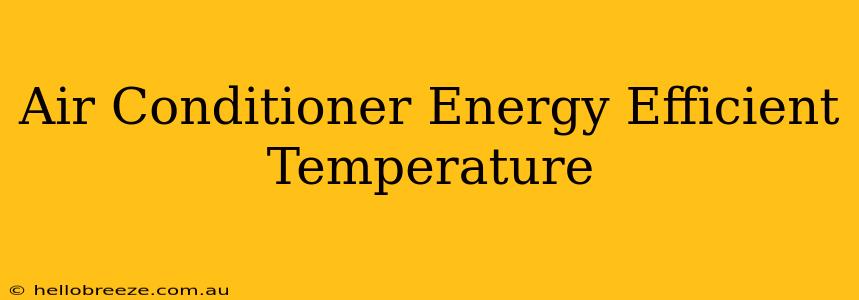Summer's heat can be brutal, making your air conditioner your best friend. But running the AC constantly can also be a major drain on your energy bill. Finding the right air conditioner energy efficient temperature is key to staying comfortable and saving money. This guide will help you find that perfect balance.
Understanding the Relationship Between Temperature and Energy Consumption
The hotter you set your thermostat, the less energy your AC will use. However, there's a point of diminishing returns. Setting it too high can make your home uncomfortably warm, leading to frustration and potentially higher energy bills in the long run (because you'll be tempted to run it more!).
The Goldilocks Zone: Finding the Right Temperature
The ideal air conditioner energy efficient temperature is often cited as between 78°F and 80°F (25.5°C and 26.7°C) when you're home. This range provides reasonable comfort for most people while minimizing energy consumption. When you're away from home, you can raise the temperature even higher – even up to 85°F (29.4°C) – to maximize savings.
Tips for Maximizing Energy Efficiency
Setting the thermostat isn't the only factor influencing your AC's energy consumption. Several other strategies can help you save:
1. Regular Maintenance is Crucial
Regular maintenance, including cleaning or replacing air filters, is essential. A dirty filter restricts airflow, forcing your AC to work harder and consume more energy. Consider professional servicing at least once a year to ensure your system is running optimally.
2. Seal and Insulate Your Home
Proper sealing and insulation prevent cool air from escaping and hot air from entering. This reduces the load on your AC, leading to lower energy use and better temperature regulation. Consider weatherstripping doors and windows, and adding insulation to attics and walls.
3. Utilize Smart Thermostats
Smart thermostats can learn your preferences and adjust the temperature automatically, optimizing energy use while maintaining comfort. They often offer features like geofencing (automatically adjusting temperature when you're away) and energy-saving modes.
4. Strategic Window Treatments
Utilize blinds, curtains, or shades to block sunlight during the hottest parts of the day. This reduces the amount of heat entering your home, decreasing the workload on your AC.
5. Choose Energy-Efficient Appliances
When replacing appliances, opt for those with high Energy Star ratings. These appliances are designed to be significantly more energy-efficient than standard models.
Beyond Temperature: Other Factors Affecting Energy Use
Your AC's energy consumption isn't solely determined by the thermostat setting. Factors like:
- The size of your home: Larger homes require more cooling.
- Insulation and sealing: Poor insulation and sealing lead to increased energy loss.
- The age and efficiency of your AC unit: Older units are generally less efficient.
- Your climate: Hotter and more humid climates demand more cooling.
Consider these factors when assessing your energy use and exploring ways to improve efficiency.
Conclusion: Finding the Perfect Balance
Finding the right air conditioner energy efficient temperature is a balance between comfort and cost. By implementing the tips outlined above and setting your thermostat strategically, you can significantly reduce your energy consumption without sacrificing comfort. Remember that consistent maintenance and thoughtful choices are key to maximizing energy savings and extending the life of your air conditioning system.

